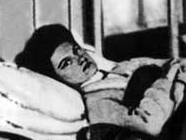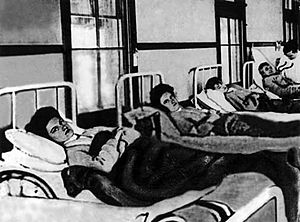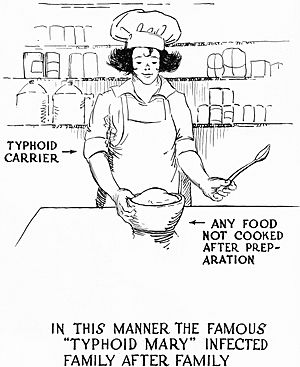Mary Mallon facts for kids
Quick facts for kids
Mary Mallon
|
|
|---|---|

Mallon in 1909
|
|
| Born | September 23, 1869 Cookstown, County Tyrone, Ireland
|
| Died | November 11, 1938 (aged 69) North Brother Island, New York, U.S.
|
| Resting place | Saint Raymond's Cemetery, The Bronx, New York, U.S. |
| Other names |
|
| Occupation | Cook |
| Known for | Asymptomatic carrier of typhoid fever |
Mary Mallon (born September 23, 1869 – died November 11, 1938) was an Irish-born American cook. She became known as Typhoid Mary because she was believed to have spread typhoid fever to many people.
Typhoid fever is a serious illness. Mary Mallon was the first person in the United States found to be an asymptomatic carrier. This means she carried the typhoid bacteria Salmonella typhi in her body but did not get sick herself. However, she could still pass the disease to others.
Because she kept working as a cook, she exposed many people to the illness. Health officials forcibly quarantined her twice to stop the spread. She spent almost 30 years in isolation. Her nickname, "Typhoid Mary," is now used for anyone who spreads disease or bad luck, even if they don't mean to.
Contents
Mary Mallon's Life Story
Early Years and Moving to America
Mary Mallon was born in 1869 in Cookstown, County Tyrone, Ireland. When she was about 15, she moved from Ireland to the United States.
She first lived with her aunt and uncle. She worked as a maid for a while. Later, she became a cook for rich families.
Working as a Cook and Spreading Typhoid
From 1900 to 1907, Mary Mallon worked as a cook for eight families in the New York City area. Seven of these families got typhoid fever.
For example, in 1900, she worked in Mamaroneck, New York. Within two weeks, people there got sick with typhoid. She moved to Manhattan in 1901. Again, family members she worked for developed fevers and diarrhea.
In 1904, she worked for a lawyer named Henry Gilsey. Four of his seven servants became ill. Mary Mallon then left and found a new job in Tuxedo Park. There, a laundry worker in the household got typhoid and later died.
In August 1906, she worked for the Charles Henry Warren family in Oyster Bay. Six of the 11 people in the family got typhoid fever. This disease was very unusual in Oyster Bay at that time. The property owner hired experts to find the source. They tested water samples, but found nothing.
In late 1906, Mary Mallon worked for Walter Bowen. Their maid got sick, and soon two other servants were in the hospital. The family's daughter also got typhoid and sadly died.
How Mary Mallon Was Discovered
George Soper was an investigator hired to find the cause of typhoid outbreaks. He noticed that a female Irish cook was involved in many outbreaks among wealthy families. He couldn't find her because she usually left after an outbreak started.
The outbreak at the Bowen family's home helped identify Mary Mallon. Soper learned that she was the cook there. He met her in the Bowens' kitchen and told her she was spreading the disease. Mary Mallon got very angry and threatened him with a carving fork.
She refused to give samples for testing. So, Soper looked into her past jobs. He found that members of seven out of eight families she cooked for had gotten typhoid fever. Soper then tried again with a doctor, but Mary Mallon still refused. She believed the outbreaks were from bad food or water. At that time, many people, even healthcare workers, didn't understand how healthy people could carry diseases.
Soper published his findings in a medical journal in June 1907.
Mary Mallon's Quarantines
First Time in Isolation (1907–1910)
After Soper told the New York City Health Department, they realized Mary Mallon was a typhoid carrier. She was arrested as a public health risk. Five policemen and Dr. Josephine Baker took her to the Willard Parker Hospital. Dr. Baker even had to sit on Mary Mallon to hold her still.
At the hospital, she was forced to give samples. Doctors found a huge number of typhoid bacteria in her stool. This showed the infection was in her gallbladder. Mary Mallon admitted she almost never washed her hands. At the time, the idea that tiny germs caused disease was not fully accepted by everyone.
On March 19, 1907, Mary Mallon was sent to be quarantined on North Brother Island. While there, she gave samples three times a week. Doctors suggested removing her gallbladder, but she refused. She didn't believe she had the disease. Also, gallbladder surgery was very risky back then.
Mary Mallon also didn't want to stop cooking. Cooking paid more than other jobs, and she needed the money. After Soper's article, the media called her "Typhoid Mary." This nickname stuck.
Mary Mallon never believed she was a carrier. She even sent some samples to a different lab, and they came back negative. After almost three years, health officials said she could be freed. But she had to agree to stop working as a cook and take steps to prevent spreading typhoid. On February 19, 1910, she promised to change her job and be careful. She was then released.
Release and Second Isolation (1915–1938)
After her release, Mary Mallon worked as a laundry worker. This job paid much less than cooking. She later hurt her arm and couldn't work for six months.
After a few difficult years, she started cooking again. She used fake names like Mary Brown. She took cooking jobs even though health officials told her not to. Agencies that hired servants for rich families wouldn't hire her. So, she worked in restaurants, hotels, and spas.
Almost everywhere she worked, there were outbreaks of typhoid. But she changed jobs often, so George Soper couldn't find her.
In 1915, Mary Mallon worked at Sloane Hospital for Women in New York City. Soon, 25 people got infected, and two died. Dr. Edward B. Cragin, a head doctor, called Soper for help. Soper recognized Mary Mallon from descriptions and her handwriting.
Mary Mallon tried to run away again. But the police found her and arrested her. She was sent back to quarantine on North Brother Island on March 27, 1915.
She stayed on North Brother Island for over 23 years. The authorities gave her a small private cottage. After 1918, she was allowed to take day trips to the mainland. In 1925, a doctor named Alexandra Plavska came to the island. She set up a lab and offered Mary Mallon a job as a technician. Mary Mallon washed bottles and helped prepare things for pathologists.
Mary Mallon's Death
Mary Mallon spent the rest of her life in quarantine at Riverside Hospital on North Brother Island. She was active until she had a stroke in 1932. After that, she was mostly in the hospital and half of her body was paralyzed.
On November 11, 1938, she died of pneumonia at age 69. Her body was cremated, and her ashes were buried at Saint Raymond's Cemetery in the Bronx. Nine people attended her funeral.
Some reports say that an autopsy (a medical exam after death) found live typhoid bacteria in her gallbladder. However, George Soper said there was no autopsy. Some researchers believe this claim was made to calm the public after her death.
Mary Mallon's Legacy
What We Learned from Her Case
Mary Mallon's case was the first time an asymptomatic carrier of typhoid was found and isolated. Her story brought up important questions about public health and individual rights.
Researchers believe Mary Mallon infected "at least one hundred and twenty two people." This includes five confirmed deaths. Some estimates suggest she might have caused up to 50 deaths. Because she didn't cooperate, the exact number is not known.
In the early 1900s, there were no antibiotics to fight infections. Removing the gallbladder was also a very dangerous surgery. Mary Mallon's case helped scientists understand that some people could carry diseases without getting sick themselves.
The Ethical Questions
Mary Mallon's arrest and forced quarantine still spark debate today. Was it right to arrest her and keep her isolated?
Some historians argue that Mary Mallon knew she was infecting people. They point out how often typhoid appeared after she left a job. Also, 10% of people who got typhoid from her died. They argue that if she knew, her arrest was justified to protect others.
Others argue that Mary Mallon didn't know she carried the bacteria. At the time, asymptomatic carriers were not understood. Mary Mallon said she didn't feel sick or look sick. She believed she was healthy. So, they argue she shouldn't have been arrested for something she didn't know she was doing.
How Her Case Changed Public Health
Mary Mallon was the first person found to be a healthy carrier of the typhoid germ. Health officials didn't know how to handle someone like her.
However, her case helped officials learn how to identify other people who carried diseases without showing symptoms. Her story changed how people thought about personal freedom versus public safety. It also helped turn the idea of an asymptomatic carrier into a proven scientific fact.
Mary Mallon in Culture
Today, the phrase "Typhoid Mary" is a common term. It means anyone who, on purpose or by accident, spreads disease or something else bad.
- A supervillain in Marvel Comics is named Typhoid Mary Fisk.
- A rap group is named Hail Mary Mallon.
- Mary Mallon was shown in the TV show The Knick.
- A fictional butcher knife linked to Mary Mallon appeared in the TV show Warehouse 13. This knife could transfer illnesses between people holding it.
See also
 In Spanish: María Tifoidea para niños
In Spanish: María Tifoidea para niños




